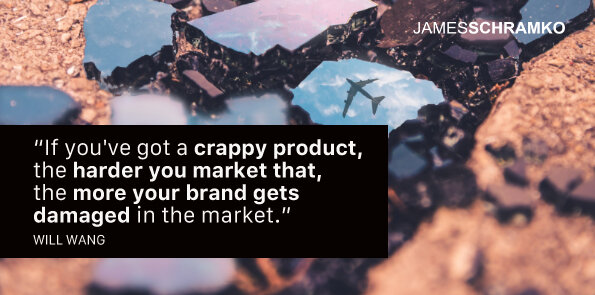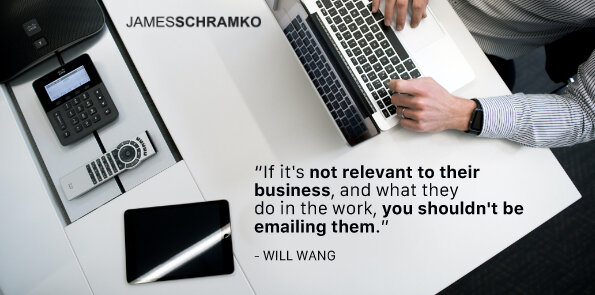Podcast: Download (Duration: 33:55 — 31.8MB)
Get Notified Of Future Episodes Apple Podcasts | Spotify | Amazon Music | Android | Blubrry | Gaana | TuneIn | Deezer | Anghami | RSS | More
In this episode of James’s podcast, he and regular guest, Will Wang, delve into the topic of B2B lead generation, specifically the power and effectiveness of cold email campaigns.
Back when James worked for the likes of Mercedes-Benz and Vodafone, these large corporations, despite widespread brand presence, still relied on cold outreach as a major strategy.
Early in his cold email journey, Will was surprised to find that big corporate names, which one would assume wouldn’t need cold emails, actively used them for their marketing.
Together, James and Will will look at the reasons why cold email outreach is still a tool of choice for such companies.
They’ll discuss the effectiveness of cold email in generating qualified leads.
And they’ll talk about the elements of cold email best practices.
Table of contents:
1. Why do cold email?
2. Setting the groundwork for cold emails
3. The real or perceived downsides of cold email
4. Working on the targeting
5. Building a quality prospect list
6. What goes into the email?
7. A contracting market
8. The legal considerations around cold email
9. Three important things to have with cold email
10. What does success look like?
11. Where the emails come from
12. A couple of case studies
13. Who could benefit from Will’s help?
Why do cold email?
Will identifies two primary reasons for companies, both large and small, to consider cold emails.
First, the diminishing performance of paid advertising means companies are getting fewer leads and conversions for their ad spend, making alternative outreach methods necessary.
Second, cold emails offer superior targeting. Even platforms like LinkedIn, often hailed for their targeting potential, might not consistently reach a desired audience, such as top-tier corporate CEOs. Cold emailing, on the other hand, lets businesses directly approach and build relationships with these decision-makers, bypassing gatekeepers like executive assistants.
Setting the groundwork for cold emails
How important is a quality product or service in conjunction with effective marketing, asks James?
In today’s interconnected world, says Will, while good marketing can amplify a product’s reach, marketing a subpar product can quickly damage a brand’s reputation.
Companies with a solid reputation and quality offerings achieve better results, especially in email campaigns, than those with questionable reputations.
The real or perceived downsides of cold email
Will Wang highlights a significant downside of cold email: if done incorrectly, they can badly damage a brand’s reputation.
An example is a leading Australian tech company that faced backlash on LinkedIn due to poorly executed cold emails.
Will’s company, GrowthLabz, has both taught clients to execute effective cold emails and offered direct services.
In fact, after analyzing a vast amount of data from their cold email campaigns, GrowthLabz has created a template pack encapsulating their most effective strategies, which interested parties can download. Simply shoot an email to [email protected].
Working on the targeting
In cold outreach, Will stresses that accurate targeting is paramount. He identifies three crucial elements in the cold email process: targeting, messaging, and nurture/sales.
Without the right targeting, even the most persuasive message will fall flat. Many businesses blindly target all potential leads without proper research, leading to scenarios where, for instance, an SEO provider attempts to sell services to another SEO business.
Proper research ensures that outreach is meaningful and relevant.
Building a quality prospect list
To build an effective prospect list, it’s imperative to understand the entire sales process and identify all potential stakeholders who might be involved.
Will emphasizes that knowing who to speak to, whether it’s heads of growth, CEOs, or other department leaders, is the initial step. Leveraging available tools, he recommends extracting more than just email addresses; deep research into recent activities such as LinkedIn posts or podcast episodes can help in crafting personalized outreach emails, for a higher success rate.
This level of personalization, referencing specific content or actions of the prospect, differentiates the outreach and makes it resonate.
Another strategy that Will employs is around leveraging events. Whether attending an existing event or creating a tailored event, such as a “lunch and learn”, the goal is to establish relevance and create an opportunity that the target audience will genuinely be excited about. This approach ensures the outreach is both meaningful and valuable.
What goes into the email?
In today’s fast-paced environment, the approach to cold emailing has evolved. Where in the past, standard practice was to ask for a short phone call to discuss potential collaboration or service offerings, the busier schedules of recipients have made this approach less effective.
Will suggests providing value upfront without expecting immediate results. By sharing content or offering value first, the aim is to nurture potential leads over time. This might take longer to yield tangible results, but when conversions happen, they tend to be more genuine and characterized by smoother sales processes.
While the success of direct calls to action, like requesting for a short call or demo, has declined, it is still an effective strategy for some audiences. The responses might be fewer, but they often result in high-quality leads with a higher likelihood of converting.
Will notes that the effectiveness of the approach can also be influenced by market sentiment, meaning businesses should be flexible and adjust their strategies based on the market’s responsiveness.
A contracting market
Will observes the current situation as a bear market, based on data trends from various industries.
Indicators such as increased email open rates but decreased reply rates on campaigns tell of a more cautious approach from potential clients.
In addition, sales cycles have become longer, indicating that decision-making is now more prolonged. Initial order values for services or software have decreased, implying wariness in initial purchasing. There does remain, though, a chance to secure larger budgets if the initial service impresses the client.
James recognizes the market contraction and points out that businesses often cut their marketing budgets during such times, which could be counterproductive.
Cold outreach remains an effective strategy, especially when it’s professionally done, given the competition on other platforms. James emphasizes the need for businesses to up their game, given that many still overlook this strategy, making it a potentially lucrative option.
Other indicators suggest a contracting market. James cites declining prices for secondhand goods, proactive outreach from service providers like real estate agents and car services, and feedback from community groups about financial strains.
These are signs that consumers and businesses alike have become more prudent with their spending. For B2B marketers, this means crafting outreach strategies with great professionalism, considering decision-makers will be more selective and discerning in their choices.
The legal considerations around cold email
In certain countries there are strict regulations surrounding cold emails. Will warns against cold emailing in Canada and Germany, for instance, due to their stringent policies. Better not to risk one’s business or reputation.
While countries like the US, UK, and New Zealand have more lenient laws, businesses should still be cautious and adhere to specific guidelines. It’s crucial to consult legal experts to ensure compliance.
James notes that large companies often have in-house legal teams to vet their cold emailing practices.
Three important things to have with cold email
Cold emailing calls for best practices to ensure both effectiveness and compliance.
First and foremost, says Will, provide recipients an easy way to opt out of further communication. This could be a simple link they can click or an option to reply with a request to stop future emails.
Secondly, the content of the cold email should be relevant to the recipient’s role and business. Sending unrelated or random information can not only lead to unresponsiveness but could also border on non-compliance from a legal standpoint.
Lastly, businesses should strictly send cold emails to recipients’ professional or work email addresses, avoiding personal emails like Gmail or Yahoo. Using personal email addresses can lead to issues with email servers, which are set to flag cold emails, potentially damaging the sender’s reputation.
What does success look like?
Measuring success in cold email campaigns revolves around return on investment (ROI). While many focus on metrics like open rates and reply rates, the true indicator of success is the profitability of the email sequence.
This involves examining leads further down the sales funnel to determine their conversion over time. If the ROI isn’t satisfactory, it’s essential to reverse engineer the process and identify problem areas, from sales calls booked to reply rates and open rates.
This step-by-step backward analysis is crucial for figuring out the adjustments needed to optimize for better results.
The effectiveness of a cold email campaign also ties back to the sales team’s performance. There’s often a clash between sales and marketing, with disputes over lead quality. To mitigate this, ensuring alignment between the two is critical.
Getting buy-in from sales leaders, involving them in approving leads and messaging, can help create a unified front, ensuring that leads coming through the pipeline are truly qualified and the messaging aligns with the sales strategy.
Where the emails come from
Will explains that they purchase separate domains for sending cold emails, to safeguard the reputation of the main company domain. Using different domains ensures that if emails get marked as spam, it won’t impact the primary domain’s reputation or interfere with essential communications like invoices.
Only after a recipient responds affirmatively or schedules a sales call does the information get moved to the client’s CRM system.
James points out that many recipients scrutinize sender addresses to determine if they’re legit. To address this, Will redirects the separate email domains to the primary company domain, ensuring that if recipients manually enter the domain they see in the email, they are directed to the official company website.
A couple of case studies
Will shares a successful campaign case study for a financial services business that targets listed companies. The campaign approached 500 CEOs and CFOs from Australia’s top 1000 companies. With impressive open and reply rates, this resulted in a pipeline worth tens of millions.
The success could be attributed to personalized messaging based on research about each company and its CEO, demonstrating the impact of well-crafted outreach.
Will also cites their work with Airwallex, a notable Australian company. Instead of executing campaigns for them, they educated the Airwallex team on their lead generation system. This enabled Airwallex’s sales team to focus on their strengths while virtual assistants handled lead generation.
Who could benefit from Will’s help?
Who should be reaching out to Will, asks James?
GrowthLabz.com primarily assists two types of companies with cold outreach. First, larger corporations with sales teams who need a continuous stream of leads; Will and his team manage the entire outreach process for them.
Second, they work increasingly with small businesses, such as consultants, corporate coaching firms, SEO agencies, and designers. These businesses, even if they are just a few people strong, can greatly benefit from the structured outreach approach that GrowthLabz offers.
If you’re interested in Will’s help, check out GrowthLabz.com. And look for future episodes on lead generation with Will.
Liked the show? Leave us a review on iTunes












Leave a Reply